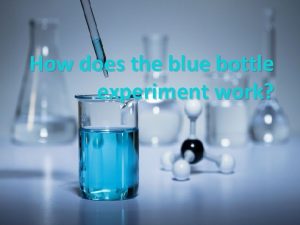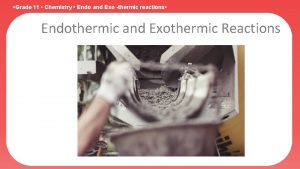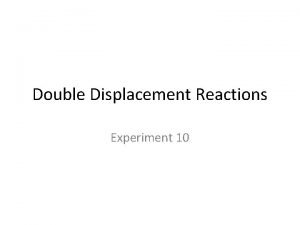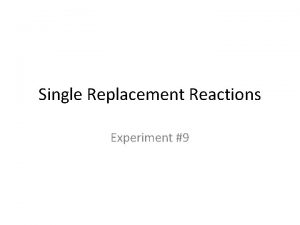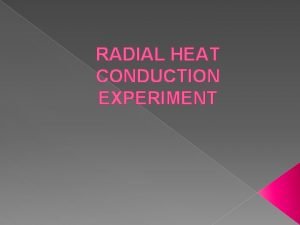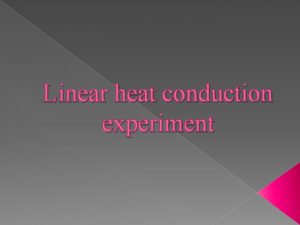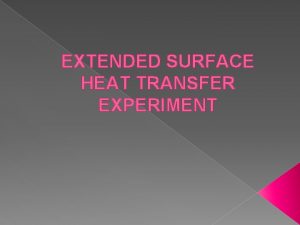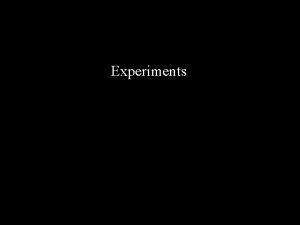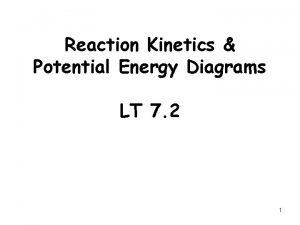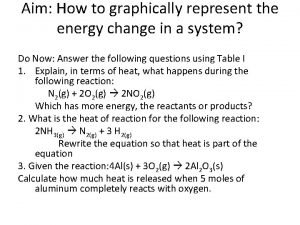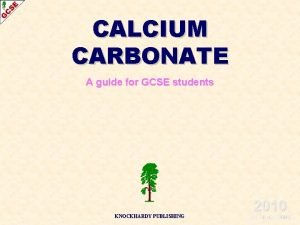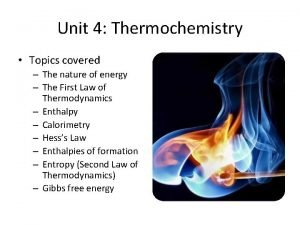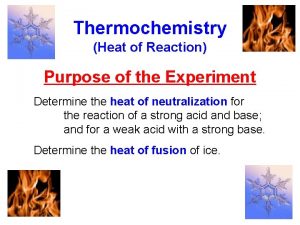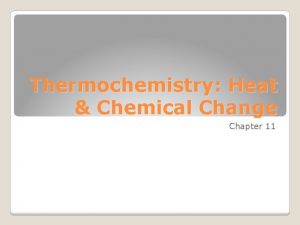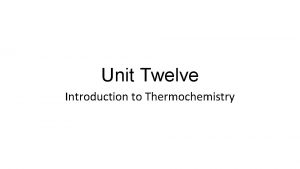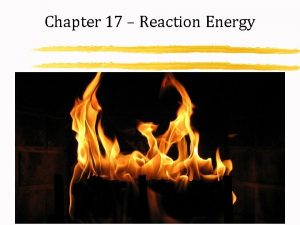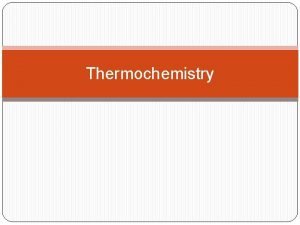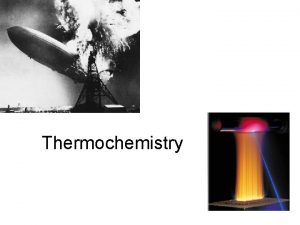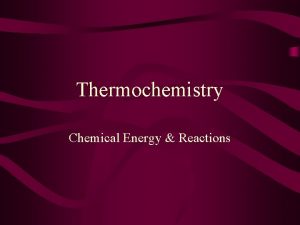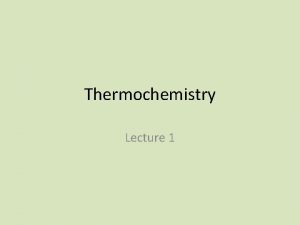Thermochemistry Heat of Reaction Purpose of the Experiment




















- Slides: 20

Thermochemistry (Heat of Reaction) Purpose of the Experiment Determine the heat of neutralization for the reaction of various acids and bases. Determine the heat of fusion of ice.

What is the Heat of Reaction? Definition of Enthalpy Thermodynamic Definition of Enthalpy (H): H = E + PV E = energy of the system P = pressure of the system V = volume of the system

At Constant Pressure Recall, by definition a change in energy equals heat transferred (q) plus work (w): E = q + w Consider a process carried out at constant pressure. At constant pressure, work involves only a change in volume. We can then substitute -P V for w. E = qp - P V Then if we want to solve for the heat transferred, qp, at constant pressure, we simply rearrange the equation. qp = E + P V

Enthalpy = Heat Transferred Recall our original definition of enthalpy: H = E + PV Then for a change in enthalpy: H = E + (PV) If we set P constant, then: H = E + P V Since qp = E + P V Then H = qp The change in enthalpy, H, is then equal to the heat transferred at constant pressure, qp.

In a chemical reaction H = H products – H reactants If H <0, then qp <0 The reaction is Exothermic. Heat goes from the system into the surroundings. An example of an exothermic reaction: If H >0, then qp >0 The reaction is Endothermic. Heat goes from the surroundings into the system. http: //www. youtube. com/watch? v=rd. Csb. Zf 1_Ng

Heat Capacity, C “C” is an extensive property; so a large object has a larger heat capacity than a small object made of the same material. Using the Equation: Looking at the figures on the left, it can be seen that the temperature change is constant, but the heat absorbed by the larger object is greater. This results in a larger heat capacity for the larger object because more heat is absorbed.

v. Specific heat capacity: The energy (joules) required to raise the temperature of 1 gram of substance by 1 C Unit: J g-1 K-1 or J g-1 1 C-1 v. Molar heat capacity: The energy (joules) required to raise the temperature of 1 mol of substance by 1 C Unit: J mol-1 K-1 or J mol-1 1 C-1

Specific Heat, Cs Substance (cal/gram°C) (J/kg °C) Pure water 1. 00 4, 186* Wet mud 0. 60 2, 512 Ice (0 °C) 0. 50 2, 093 Sandy clay 0. 33 1, 381 Dry air (sea level) 0. 24 1, 005 Quartz sand 0. 19 295 Granite 0. 19 294 1 calorie = 4. 186 joules *The high heat capacity of water makes it ideal for storing heat in solar heating systems.

Neutralization The reaction between an acid and a base which results in a salt plus water. For example, hydrochloric acid and sodium hydroxide: HClaq + Na. OHaq Na. Claq + H 2 O acid + base salt + water Another example, cyanic acid and a hydroxide ion. If we use KOH, what salt will form?

Heat of Neutralization Net ionic equation for neutralization: H+(aq) + OH-(aq) H 2 O(l) Energy released by reaction = Energy absorbed by solution Specific heat capacity, Cs, is defined as the quantity of heat transferred, q, divided by the mass of the substance times the change in temperature. A value of Cs is specific to the given substance. Cs = q / [(mass) (Tfinal-Tinitial)] This can then be rearranged to solve for the heat transferred. q = (mass) Cs (Tfinal-Tinitial)

Enthalpy of Fusion (Melting) Enthalpy of Fusion is defined as the heat that is absorbed when the melting occurs at constant pressure. If the substance freezes, the reaction is reversed, and an equal amount of heat is given off to the surroundings; i. e. , ΔHfreez = - ΔHfus solid liquid Melting (fusion) is an endothermic process

Calorimetry A calorimeter can be created by doing something as simple as inserting one Styrofoam cup inside another. Science of measuring heat based on observing the temperature change when a body absorbs or loses energy as heat.

Calorimetry A Calorimeter may be used to determine the Heat Capacity, Cs, of a material by measuring the temperature change when a known mass of the material at a higher temperature is placed in a known mass of water, usually at room temperature, and the system is allowed to reach a final intermediate temperature. Heat lost by hot object = Heat gained by cold water (mass)material Cs material (Tfinal-Tinitial)material = -(mass)water Cs water (Tfinal-Tinitial)water Note: The heat capacity is related to the atomic mass and the intermolecular forces in the material. is a mnemonic – an easy way to remember m. Cs T

Calorimetry A Calorimeter may be used in a similar manner to determine the enthalpy change associated with other processes, such as: ØChemical reactions* (bond energies) ØPhase changes* (intermolecular forces) ØMixing (intermolecular forces) ØSolvation (intermolecular forces) *These are the processes you will be learning today.

Have you ever wondered about how they determine the calories in food? They use a Bomb Calorimeter. It can be used to determine the caloric value of food and of fuels, by burning them in excess oxygen and measuring the amount of heat evolved. A basic combustion reaction: Cx. Hy + O 2(excess) --> x CO 2 + y/2 H 2 O + heat Bomb Calorimeter An example of an exothermic reaction from the S&T mining dept: http: //www. youtube. com/watch? v=CIGJPWAyn. DQ

The Computer Display Setup for Today’s Experiments If probe displays less than 15 o. C, notify your TA. Parameters: Temperature: 10 -50 o. C Time: 0 -1000 seconds (Check: Probe should display 15 -25 o. C resting on lab bench and should read higher when warmed by hand. )

The Heat of Neutralization Experiments Mixture not stirred fast enough – Resulting line is not vertical. Reaction is completed, heat released, begin slow cooling to ambient HCl and Na. OH mixed, reaction begins Temperature change is important. Exact time is not important. Temperature will drift toward ambient before and after reaction Transition will be faster if Na. OH is added rapidly and well stirred. (That is, you will have a more nearly vertical temp. rise. )

The Heat of Fusion Experiment Ice cube added Mixture not stirred fast enough – Resulting line is not vertical. Melting complete, begin slow warming IMPORTANT: a. ) Use only 1 ice cube; b. ) the entire cube must melt.

Checkout 1 - Calorimeter (Thermos) 1 - Styrofoam Cup 1 – 100 ml Graduated Cylinder – When all experiments are completed, rinse with water and return all 3 items to the stockroom. Reagents in Lab (Record concentration from carboys onto datasheets. Note: Concentrations may vary from one class to the next. ) _____M HCl (strong acid) _____M CH 3 CO 2 H (weak acid) _____M Na. OH (strong base) Important: Use distilled water from carboys*, NOT from the tap. (*Distilled water from the tap is normally not at room temp. )

Hazards HCl, strong acid, corrosive CH 3 CO 2 H, weak acid, corrosive Na. OH, strong base, corrosive Waste Liquid waste labeled “Heat of Neutralization” For April 7 -9 Due: Thermochemistry pp 91 -102 in the lab packet and a calculations page and Dimensional Analysis #4 -5 in the first book* 4. 1 & 4. 2: a, c, f, & h only; 5. 1 – 5. 4: a & c only Read over: “Antacid Analysis” pp 103 -118 in the lab packet *Lost your 1 st book? Go to http: //web. mst. edu/~tbone/Subjects/TBone/Chem 2. html
 Blue bottle experiment chemical equation
Blue bottle experiment chemical equation Endo exo thermic
Endo exo thermic Double displacement reaction experiment
Double displacement reaction experiment Single replacement reaction experiment
Single replacement reaction experiment Radial heat conduction lab report
Radial heat conduction lab report Linear heat conduction experiment
Linear heat conduction experiment Extended surface heat transfer experiment
Extended surface heat transfer experiment Clausius clapeyron equation
Clausius clapeyron equation Variabel sekunder dalam psikologi eksperimen
Variabel sekunder dalam psikologi eksperimen Reaction order
Reaction order Ictahedron
Ictahedron Leukoerythroblastic reaction vs leukemoid reaction
Leukoerythroblastic reaction vs leukemoid reaction Neutron emission
Neutron emission Potential energy diagram
Potential energy diagram The overall reaction in a commercial heat pack
The overall reaction in a commercial heat pack Potential energy diagram heat of reaction
Potential energy diagram heat of reaction Knockhardy notes
Knockhardy notes Thermal capacity
Thermal capacity Specific latent heat definition
Specific latent heat definition Moist cooking methods
Moist cooking methods Gibbs free energy unit
Gibbs free energy unit
